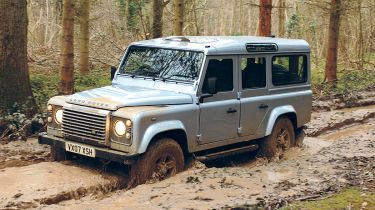Land Rover Defender 110 SW County
The legend’s updates include a new engine from a Ford Transit!
As Land Rover looks to haul the Defender into the 21st century, it’s clear one element is going to remain largely unchanged – the styling. The boxy profile is unlikely to win any beauty contents, but it’s unmistakable from any angle. And fans of the off-roader will doubtless point to the quality of the original design, which has remained pretty much unmodified in nearly 60 years.
The Defender is certainly distinctive, and few competitors have as much charm or presence. Park it alongside the Patrol, and it’s instantly noticeable how much narrower and taller the Land Rover is, while the extra ground clearance also becomes apparent. This causes problems when getting in, however – particularly for taller owners, who will find themselves having to twist their legs around the pedals. Nevertheless, once behind the wheel, the upright driving position is surprisingly comfortable, if a little cramped.
Despite the interior changes, including a reprofiled door top, there is still a shortage of right elbow room, and quick manoeuvres such
as three-point turns can prove tricky. The huge turning circle doesn’t help, either. But the new instrument cluster is easier to read and the fresh centre console is a big improvement. It’s hardly modern, yet feels more robust than the Patrol.
The fresh seats offer a welcome step up in comfort, as does the revised ventilation system – the dashboard vents no longer open direct to the outside, and the heater warms the cabin 40 per cent faster than before. Better door seals and sound insulation have helped cut noise levels, although in our tests, the Land Rover was still 6db louder than the Nissan at 30mph and 70mph.
In the rear, the Defender is no match for its rival, either. With 690mm of legroom, it trails by 100mm, while headroom is also limited. As the model is narrower, getting three in the back is a squeeze.
The Land Rover does have a trick up its sleeve, though: extra rear seats. While safety regulations mean customers are no longer able to specify the 110 Station Wagon as a 12-seater with two inwards-facing benches, it still gets seven chairs as standard. But even in 110 guise, the Defender isn’t some tarted-up people carrier – it’s a hardcore off-roader that’s unstoppable in the rough, whether confronted with thick mud trails, uneven river beds or alarmingly steep inclines. As it’s slightly narrower than the Patrol, it’s more manoeuvrable. The engine doesn’t have to be worked as hard in low range, either, while a lower first gear helps when it comes to towing.
Taken from Ford’s Transit, the new four-cylinder diesel can’t match the Patrol’s power and torque, but it feels more punchy and responsive. Also, despite a long throw, the shift action of the new six-speed gearbox is more positive. And while the motor is noisier at speed than the Nissan’s, a higher sixth ratio makes motorway cruising more relaxing than before. The engine propelled the Defender from 0-60mph in 12.7 seconds – nearly a second quicker than the Patrol – while in-gear performance was considerably better.
On the road, the Land Rover’s shortcomings remain, with body roll in bends and unresponsive steering. But new springs and revised dampers help it feel more composed than previous cars. It’s certainly much happier at higher speeds than the woolly Patrol, and the brakes are better, too.
While prices are up by £400 on average, the Defender is still good value. Although £800 pricier than the Nissan, it’s similarly equipped and has those seven seats – a key feature for many.
Details
Price: £24,795
Model tested: Land Rover Defender 110 SW County
Chart position: 1
WHY: The Defender dates back to 1948, yet while styling is similar, the latest model has 700 changes.
Economy
Despite featuring no particularly sophisticated technology, the Defender is costly to service. The first three visits to the dealer are a hefty £1,280. At least there’s a three-year recovery deal.
Servicing
Our experts haven’t worked out values for the Defender yet, but the model is among the most sought-after used mud-pluggers around, and is likely to hold its value very well.
Tax
Neither car is all that efficient or environmentally friendly. The Defender is the worse of the two, emitting 291g/km of CO2, so higher-band owners can expect to pay £3,471 a year.
Insurance
Over our test route on and off-road, the Defender returned 19.1mpg – not bad, bearing in mind it’s four-wheel drive. This is short of the official 25.7mpg, but some relaxed A-road driving would help.







